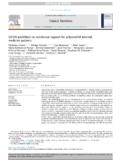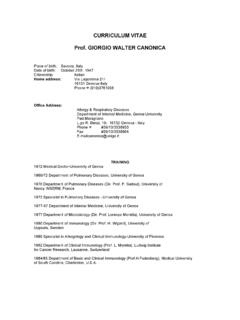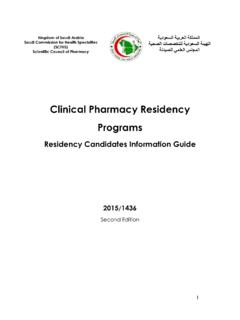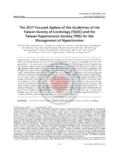Transcription of Intravenous Medication Safety and Smart Infusion …
1 Abstract Carol A. Keohaneis Project Director for the Center of Excellence for Patient Safety Research and Practice at Brigham andWomen s Hospital, Boston, Mass. The Center s efforts are aimed at improving Medication Safety across clinical Hayesis the Director of Professional Practice Quality and Staff Development at Brigham and Women s Hospital. Ms Hayes isconsidered a leader in implementing systems to improve the Medication delivery Saniukis the Clinical Educator for Advanced Heart Disease Program at Brigham and Women s Hospital. Ms. Saniuk haslectured locally and nationally on cardiovascular M. Rothschildis trained in internal medicine and critical care medicine . He is currently a hospitalist and health servicesresearcher with particular interest in patient Safety , quality improvement and informatics.
2 David W. Batesis the Chief of the Division of General medicine at Brigham and Women s Hospital, and Medical Director of Clinicaland Quality Analysis for Partners Healthcare, Boston, correspondence to: Carol A. Keohane, BSN, RN, Division of General Internal medicine and Primary Care, Brigham andWomen s Hospital, 1620 Tremont Street, Boston, MA 02120-1613 (e-mail: Institute of medicine report To Err Is Human:Building a Safe Health Systemgreatly increasednational awareness of the need to improve patientsafety in general and Medication Safety inparticular. Infusion -related errors are associatedwith the greatest risk of harm, and Smart (computerized) Infusion systems are currentlyCarol A. Keohane, BSN, RNJudy Hayes, MSN, RNCatherine Saniuk, MS, RN, CCRNJ effrey M. Rothschild, MD, MPHD avid W. Bates, MD, MScIntravenous Medication Safety and Smart Infusion SystemsLessons Learned and Future Opportunitiesavailable that can avert high-risk errors andprovide previously unavailable data for continuousquality improvement (CQI) efforts.)
3 As healthcareorganizations consider how to invest scarce dollars, Infusion nurses have a key role to play in assessingneed, evaluating technology, and selecting andimplementing specific products. This article reviewsthe need to improve Intravenous Medication describes Smart Infusion systems and the resultsthey have achieved. Finally, it details the lessonslearned and the opportunities identified throughthe use of Smart Infusion technology at Brighamand Women s Hospital in Boston, 28, No. 5, September/October 9/7/05 4:11 PM Page 321322 journal of Infusion NursingThe 1999 Institute of medicine report estimated that med-ical errors kill approximately 44,000 to 98,000 people there has been considerable controversyabout these figures,2a 2004 report by Health Grades, evaluated 37 million patient records reached an evenhigher estimate, maintaining that 195,000 people in theUnited States died in 2000, 2001, and 2002 as a result ofpotentially avoidable medical general public sexperience with medical errors is also alarming.
4 In a na-tionwide poll conducted by Lou Harris and Associates re-leased in 1997 by the National Patient Safety Foundation,42% of Americans reported either personally experienc-ing or having a family member or friend experience amedical from medications are the most frequentcause of adverse understand the incidence ofadverse events stemming from the use of medications, itis important to understand how these events are at the Division of General Internal Medicineat Brigham and Women s Hospital (BWH) recently pub-lished a report on the detection and classification methodsused to investigate the incidence, type, and preventabil-ity of adverse drug events (ADEs) and Medication their report, an incident was defined as any irregu-larity in the process of Medication use, including ADEsand Medication errors.
5 6An ADE was considered to be aninjury attributable to a Medication . A Medication error canoccur at any stage in the Medication use process (ie, order-ing, filling, dispensing, administering, or monitoring).A potentialADE (PADE) is a Medication error thathas the potential to cause harm, but does not actually doso because of circumstances, chance, or someone inter-cepting and correcting the error before it reaches example of a potential ADE is a threefoldoverdose of morphine sulfate that fortunately resulted inno apparent preventableADE is an injury that occurs as a resultof an error. An example of this would be an error by anurse in administering a drug that causes harm to the pa-tient. For example, if nipride is programmed to infuse ata rate of 4 mcg/kg/min instead of mcg/kg/min, a pa-tient could experience hypotension, a nipride-related ad-verse drug event, which is nonpreventableADE is defined as an injury that isnot the result of a Medication error.
6 NonpreventableADEs also are commonly referred to as adverse drug re-actions (ADRs).6An example of a nonpreventable ADE isseen in the case of a patient given an antibiotic for a bac-terial infection who subsequently experiences diarrhea at-tributable to Clostridium difficile. THE NEED TO IMPROVE Medication SAFETYThe Adverse Drug Event Prevention Study examinedmedical and surgical patients in two tertiary care facilitiesin the United States and found an overall rate of ADEsfor every 100 nonobstetric admissions, 28% of whichwere preventable or attributable to a Medication study, 56% of preventable ADEs occurred during theordering stage and 34% during administration. The au-thors pointed out that 48% of drug-ordering errors wereintercepted. However, 0% of administration errors wereintercepted.
7 Whereas nurses may intercept physician andpharmacist errors, no one is positioned to intercept nurses administration errors except, on occasion, the patient orfamily. The most common causes of errors occurring atthe Medication administration stage were inadequate drugknowledge, problems related to Infusion pumps, and par-enteral delivery administration errorscan be difficult to identify and may not be reported, so ithas been difficult to ascertain the true frequency of Kenneth Barker has published extensively on theuse of direct observation methods for detecting medica-tion errors at the administration stage. Using observa-tion, Barker s group studied the prevalence of medicationadministration errors in 36 institutions and found a 19%rate of this study, administration errors weredefined as doses administered differently than most common categories of error were wrong time(43%), drug omission (30%), wrong dose (17%), andunauthorized drug administration (4%).
8 Of these errors,7% had the potential for a study by Benner et al,1021 case studies of nursingerrors from nine State Boards of Nursing were analyzedin an effort to develop a taxonomy of nursing errors. Thestudy identified eight categories of nursing errors. One ofthese categories consisted of Medication errors. Theseven subtypes of Medication errors recognized include: missed doses of Medication ; wrong time of administra-tion of Medication , either more frequently or less fre-quently than ordered; IV Infusion rate too fast, deliveringtoo much Medication , wrong concentration or dosage ofmedication delivered IV; wrong route of administration(eg, oral solution, given intravenously); wrong medica-tion administered; and wrong medications delivered dueto misidentifying the patient. 10 Much research has been directed toward determiningwhere, when, and how Medication errors 1998,the United States Pharmacopeia (USP) introduced MED-MARX, an anonymous, confidential Medication reportingsystem accessible to hospitals via the Internet.
9 The goal ofthis program is to enable hospitals to report, track, andshare Medication error data in a standardized , beyond identifying errors, efforts must be di-rected toward preventing Medication errorscan be prevented by system improvements. Top prioritymust be given to averting errors associated with the great-est potential for patient 9/7/05 4:11 PM Page 322 Vol. 28, No. 5, September/October 2005323 Since the Institute of medicine s landmark report in1999, many articles have been published on the causesand contributing factors associated with medical patient Safety research and increased publicawareness are helping to create a shift in the way clini-cians and researchers approach understanding how andwhy medical errors occur. This shift involves focusing onpotential breakdowns in systems that allow errors tooccur rather than on individuals.
10 There is a move awayfrom the name, blame, and shame approach commonin years of the best-known experts and thought leaders inthe study of human error is Professor James Reason. Ac-cording to Reason,17 the basic premise in the system ap-proach is that humans are fallible and errors are to beexpected, even in the best organizations. Errors are seenas consequences rather than causes, having their originsnot so much in the perversity of human nature as in theupstream systemic factors. 17(768)Reason s system ap-proach to human error has served as a basis for many re-search efforts currently underway to identify, evaluate,and mitigate the causes of medical Medication Safety SystemsIn 2002, ECRI (formerly Emergency Care Research Insti-tute) evaluated general purpose Infusion pumps in an Ex-ecutive Summary published in Health articleevaluated 26 models and the degree to which each of SYSTEM APPROACH TO SAFETYI ntravenous medications are vital to the management ofhospitalized patients.





